What is buy the dip?

Buy the dip is a popular trading strategy where a trader or investor buys an asset whose price has suddenly fallen. By buying, they believe that the decline in the asset’s price is a temporary thing and that the price will resume the previous upward trend.
The strategy is premised on the basic principle of buying low and selling high. Importantly, the strategy can be used in all types of assets like currencies, commodities, and exchange-traded funds. It can also happen on all timeframes of these assets, including daily, hourly, and four-hourly.
Why dips happen in the market
Before we look at how to use the buy the dip strategy, we need to look at why these dips happen in the first place. First, dips happen when there is major news that affects an asset. For example, in March 2020, the World Health Organisation (WHO) declared the coronavirus illness a global pandemic. As a result, most traders rushed to the safety of the US dollar. The chart below shows how the euro declined sharply against the dollar when this happened.
Euro fell against the dollar when coronavirus was declared a pandemic
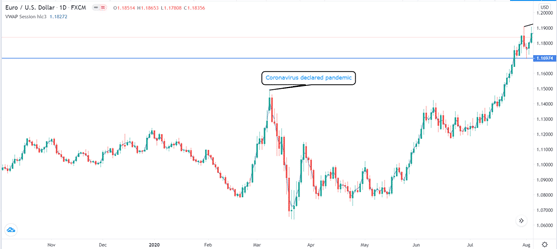
Other popular types of news that cause dips are a speech by an influential person like the president or the governor of the central bank and a geopolitical crisis.
Second, dips happen when major economic data is released. Some of the most important economic data are the nonfarm payrolls, manufacturing PMIs, retail sales, and industrial production, among others.
Third, they happen because of psychological factors. For example, a pullback can happen when a currency pair or a stock reaches an important psychological level. In the chart below, we see that the EUR/USD pair formed a minor correction when the price reached the psychological level of 1.1400. Another psychological factor is when the currency pair reaches an all-time high.
EUR/USD declined after it reached 1.1400
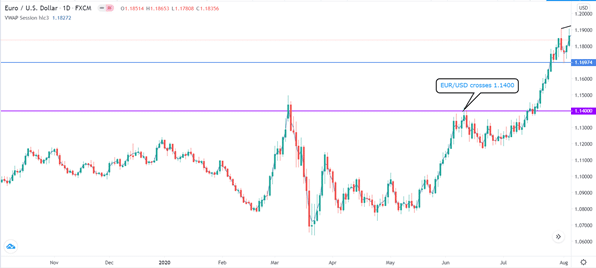
Finally, dips happen because of technical factors. For example, it may drop when it hits an important resistance as shown in the four-hour EUR/USD chart below. These dips happen because of the constant battle between bulls and bears.
Dips caused by technical factors
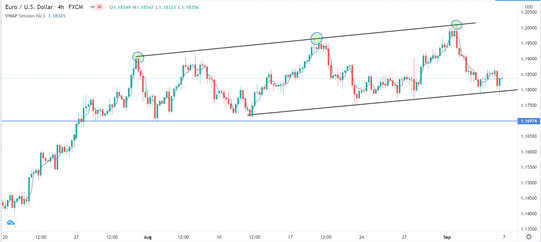
How to use the buy the dip strategy
There are several approaches to trading using the buy the dip strategy. Here is one of the approaches you can use.
Identify a trend and its causes
As mentioned, when buying the dip, the overall trend of the asset needs to be bullish. Therefore, you need to understand why the trend has been bullish in the first place. A good place to start is to establish a macro view of the asset. Some of the macro factors that could influence the movement of a currency pair are oil prices, geopolitical issues, economic growth factors, and monetary policy differentials.
A popular way to identify a trend is to conduct a multi-timeframe analysis. This is a situation where you check out the direction of an asset in various timeframes.
Identify the reason for the dip
After identifying the causes of the rally, you need to look for the cause of the sudden decline when it happens. By having a good understanding of these causes, you will be at a good position to know whether the decline is a sign of a complete reversal or whether it is temporary. For example, when a decline happens because of a sudden change in central bank policy, it could be a sign of a complete reversal.
Identify support and resistance points
Support and resistance are important concepts you need to understand when using the buy the dip strategy. For starters, support is usually a floor where the price of an asset struggles to go below while resistance is a type of ceiling. Support and resistance happen because of indecision among bulls and bears about the future price of the asset.
When a dip happens, you need to look at key support levels. If the price moves below that support, it could be a sign that the dip is a complete reversal and that the price will continue falling. The four-hour chart below is a good example.
The chart shows that the EUR/USD pair was in a strong upward trend when it reached the psychological level of 1.1900. It then declined and reached a low of 1.1700, which is also a psychological level. Most importantly, this was important support because it was the lowest level on July 27 and 28. It was also a level it had found strong resistance. Therefore, this formed a good place to buy the dip. If the price moved below 1.1700, it would have been a possible sign of a complete reversal.
Buy the dip example
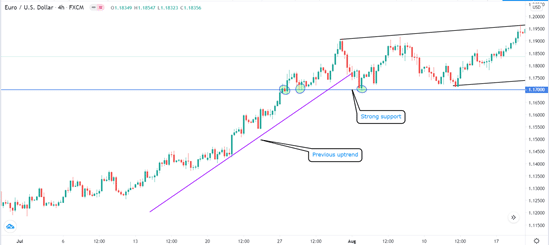
When you extend the above chart, you notice that an ascending channel that is shown in blue. As you can see, the lower side of the channel becomes an important level to buy the dip.
Support and resistance example

Using technical indicators
Another strategy to buy the dip is to combine a technical indicator with a support line. Since there are many indicators, you need to find the one that works well depending on your strategy. Moving average is a good example of an indicator that you can use. Personally, I prefer using the exponential moving average (EMA), which tends to react fast.
The idea behind this strategy is simple. When the price of an asset is in a strong upward trend, there are times when it will decline, albeit slightly. As such, when the price declines to the selected moving average, you use that as a technical dip. In the chart below, I have used the 25-day EMA to identify potential areas to buy.
Buy the dip using moving averages
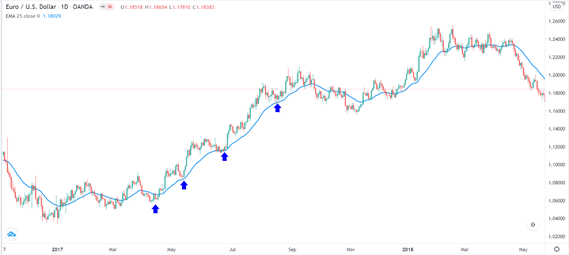
If moving averages is not your ideal indicator, you can experiment with others like Bollinger Bands, Envelopes, and Parabolic SAR.
Buy the dip opposite / selling the rip
A good thing about the forex market is that you can make money regardless of the direction of the asset. Therefore, since it is possible to make money buying the dip, you can also make it when doing the opposite; selling the rip. This is simply when you identify when an asset is in a steep downward trend, rises briefly, and then resumes the previous trend. A good example is in the EUR/USD chart shown below.
Sell the rip example
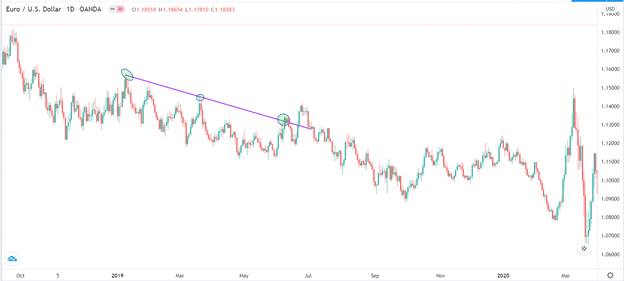
Final thoughts
Buying the dip is one of the oldest trading strategies in the market. It tends to be relatively popular among traders because it works in most times. However, since no strategy is always accurate, you need to always use the best risk management strategies in the market such as having a stop loss, managing your lot sizes, and selecting the best lot sizes.








Leave a Reply